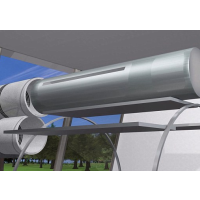Hyperloop: Musk’s Futuristic Alternative to State’s Troubled Bullet-Train
 A Hyperloop pod would ride through pressurized tubes
A Hyperloop pod would ride through pressurized tubes
Inspired by California’s stalled $68 billion bullet-train project, billionaire inventor and entrepreneur Elon Musk has unveiled a cheaper, faster mode of transportation for rocketing people from Los Angeles to San Francisco and points in between.
The Hyperloop (pdf) comes in two flavors: the $6 billion passenger-only aluminum pods and the $10 billion version that carries cars, too. The solar-powered pods, carrying 28 passengers and spaced up to 100 yards apart, would zip through pressurized tubes, elevated along the I-5 and I-580 freeways, floating on air at a top speed of 760 miles per hour, fast enough to make the L.A.-to-S.F. trip in 30 minutes. A ticket would cost $20.
Musk has been working on Hyperloop for a year, but unveiled his plans just days after the Los Angeles Times reported that the state’s high-speed rail project, pronounced shovel-ready three years ago and even shovel-readier in 2012, probably won’t turn a spade until 2014 on the first 29-mile segment in the Central Valley near Fresno. The state has secured just $12 billion of the total projected cost, originally thought to be $45 billion.
Musk told Bloomberg Businessweek that the state was building “California’s Amtrak,” a company many think symbolizes the decline of passenger rail service in the United States. “I don’t think we should do the high-speed rail thing,” he said.
There are still a few wrinkles to be worked out in Musk’s thing. For instance, Hyperloop moves quickly because it has passenger weight limits that pretty much leave fat people at the station, according to the Huffington Post. But there are other weightier questions.
For one, the science that propels Hyperloop is untested. Each capsule, with a compressor mounted on its nose, would transfer high-pressure air behind the pod. “This is like having a pump in the head of the syringe actively relieving pressure,” while reducing friction at the same time, according to Musk. It uses “the same basic principle as an air hockey table.”
But Musk has had great success in pioneering new scientific approaches to old methods of transportation. After making a fortune as co-founder of PayPal, Musk founded SpaceX, a private company whose rockets are used by NASA and its space station, and co-founded Tesla Motors, which successfully produces electric cars.
Musk is 42 years old and works fast.
–Ken Broder
To Learn More:
“Hyperloop Alpha,” Elon Musk’s “Fifth Mode” Of Transportation, Finally Unveiled (by Drew Guarini, Huffington Post)
California’s Bullet Train Builders to Elon Musk and His Hyperloop: Best of Luck! (by Karen Weise, Bloomberg Businessweek)
The Hyperloop: L.A. to S.F. in 30 Minutes? (by Catherine Green, W.J. Hennigan and Ralph Vartabedian, Los Angeles Times)
Hyperloop Would Have “Astronomical” Pricing, Unrealistic Construction Costs, Experts Say (by Eleazar David Melendez, Huffington Post)
Feds Say Environmental Law Does Not Apply to California High-Speed Rail (by Juliet Williams, Associated Press)
Why California's “Shovel Ready” Train Isn't (by Paul Whitefield, Los Angeles Times)
- Top Stories
- Controversies
- Where is the Money Going?
- California and the Nation
- Appointments and Resignations
- Unusual News
- Latest News
- California Forbids U.S. Immigration Agents from Pretending to be Police
- California Lawmakers Urged to Strip “Self-Dealing” Tax Board of Its Duties
- Big Oil’s Grip on California
- Santa Cruz Police See Homeland Security Betrayal in Use of Gang Roundup as Cover for Immigration Raid
- Oil Companies Face Deadline to Stop Polluting California Groundwater





